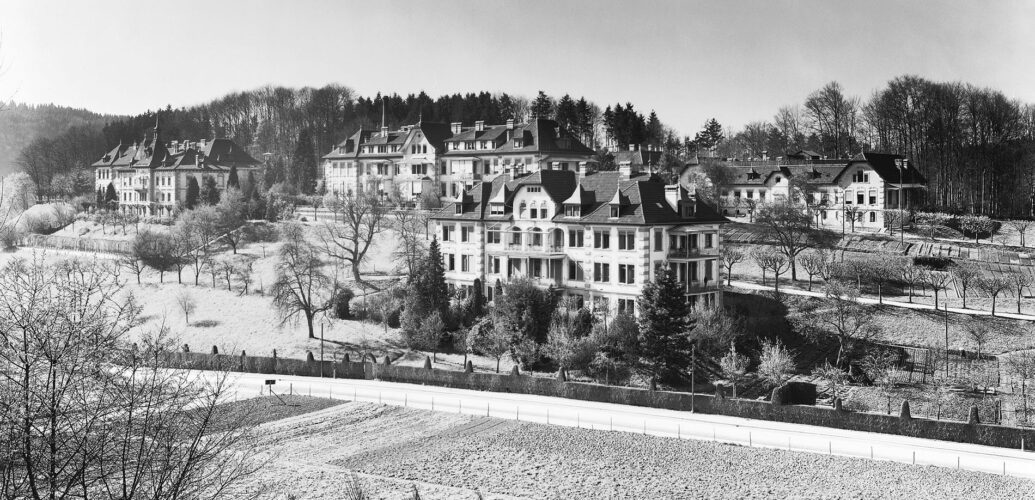Für die deutsche Version bitte hier klicken.
Inspired by the current situation, I went for a bike ride to see if I could find traces of earlier epidemics in our surroundings. Supplemented by some research, this ride ended up as a small tour through medical history.
The Plague Crosses of Ennetmoos
The tour takes me from Lucerne over the Renggpass and the Mueterschwandenberg to the hamlet of Allweg. There, on a hill in Ennetmoos in the canton of Nidwalden, are three stone crosses, popularly known as plague crosses. Plague crosses can mark gravesites of plague dead or they were erected as a reminder of the epidemic. As powerful signs of protection, crosses were also erected on village boundaries or along paths to protect the population from danger and sickness. In the case of the crosses on the Allweg, however, there is no archival evidence of these interpretations.1Odermatt Bürgi, Regula 1989. Die Wegkreuze auf dem Allweg in: Ennetmoos. Jubiläumsbuch zur 600-Jahr-Feier 1389–1989 ed. by Gemeinde Ennetmoos. Paul von Matt: Stans, S. 82–83.

The group of crosses is reminiscent of the representation of a Calvary with a larger cross in the centre, flanked by two Saint Antony’s crosses. St. Anthony is considered as the patron saint of farmers and their livestock, and in the Middle Ages it was hoped that his relics would provide protection against St. Anthony’s fire – a disease caused by grain contaminated with ergot. Therefore, the interpretation that these crosses were erected to ward off diseases does seem plausible and has found its way, if not into historical sources, then into everyday knowledge. There is historical evidence, however, that they existed as wooden crosses at least since the 17th century and that a certain significance was attached to them. At that time, it was decided that the old rotten crosses should be re-erected at the expense of the authorities. The stone crosses still visible today date from 1753 – as noted on the middle cross – and have thus been there for over 250 years – although not always in the same place. In the early 20th century, when they were in danger of falling victim to building development, the then president of the Historical Society wrote to the Ennetmoos municipal council “that these crosses are part of the landscape and if they were removed, the landscape would lose much of its beauty and charm”.

In the present day, this charming landscape can only be guessed at. The three crosses have been moved and can hardly be seen from the road. Nowadays they are hidden behind modern, somewhat characterless apartment blocks. In their shadows, the weathered crosses seem fey and out of time. The current location gives them an almost intimate character and, as a tourist from outside the village, I feel uncomfortable when I stop on the street behind the houses to take a photo. My impression is reinforced when windows are closed and curtains are drawn in my back. In former times, when the crosses were still visible from far away on the hill, they must have been an impressive sign and one can well imagine that an important protective function was attributed to them. On the way back, I schuss down to Stans. I pass the Nidwalden Cantonal Hospital and turn off at the roundabout towards Stansstad. From there I cycle in the shadow of the motorway along the Lake back to Lucerne.
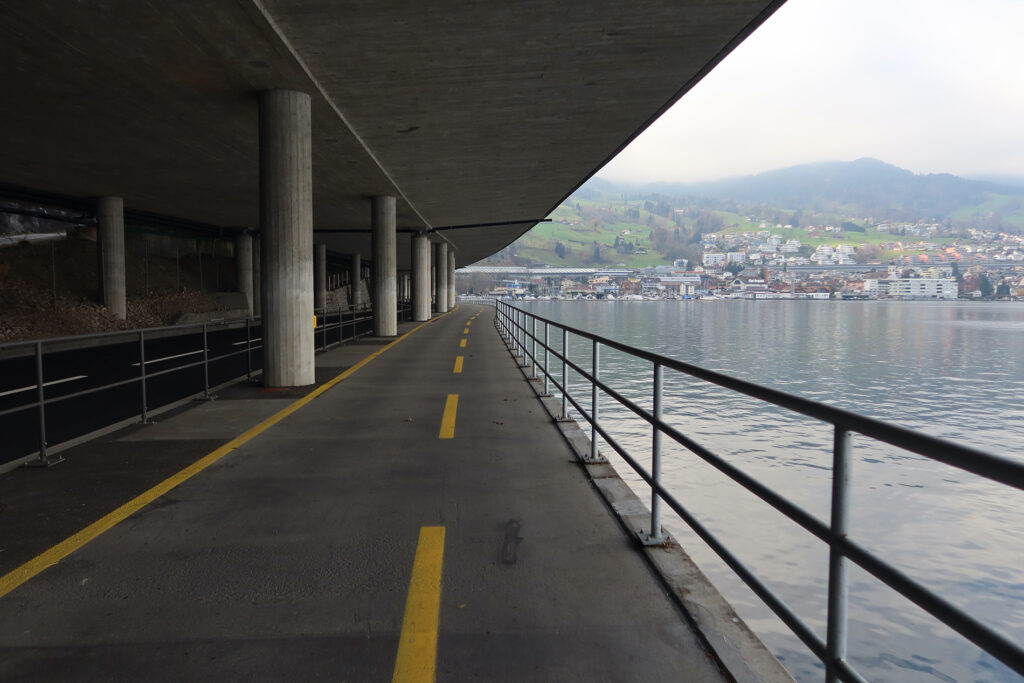
The Bürgerspital of Lucerne
Back in town, I pass the police building and parts of the municipal administration. While researching for this bike tour, I am surprised to discover that this well-familiar building was Lucerne’s central hospital until the turn of the 20th century.2Schüpbach, Werner 1983. Die Bevölkerung der Stadt Luzern 1850–1914. Demographie, Wohnverhältnisse, Hygiene und medizinische Versorgung. Rex-Verlag: Luzern, Stuttgart, S. 228–243. It was built in the mid-17th century to care for transients, the poor, the sick and the welfare dependents of the city of Lucerne. In the course of the 19th century it became the place to go for people in need of care from the entire canton of Lucerne.
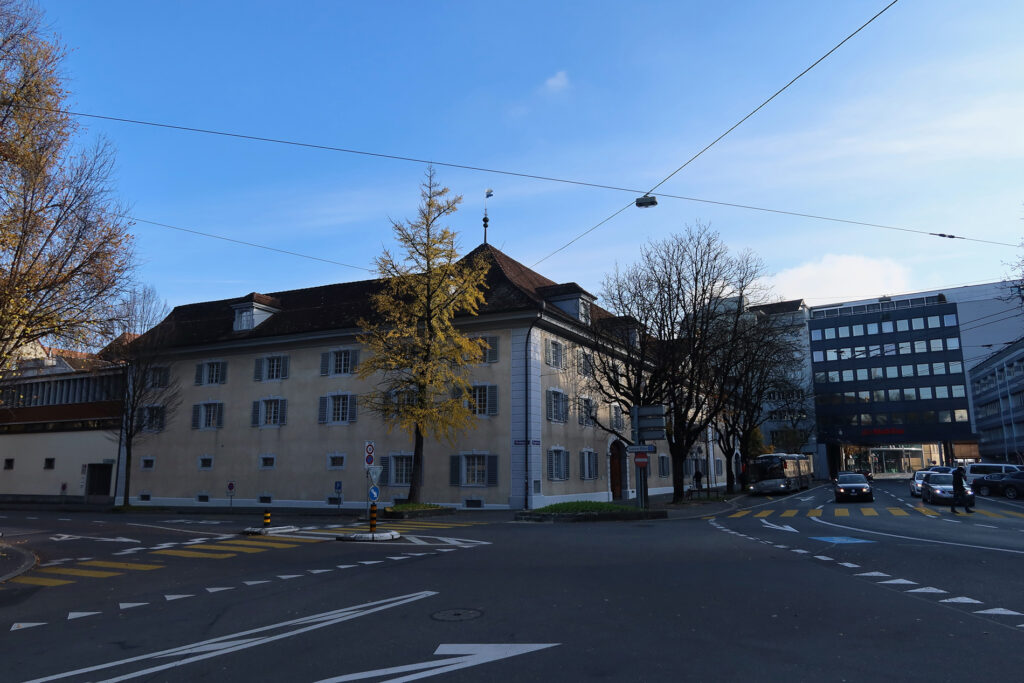
In the second half of the 19th century, the Bürgerspital slowly outgrew its function as a hospital for the poor and criticism of the hospital grew louder. There were complaints that the patients were not housed separately according to illness, that the staff was unqualified and that the doctors were incompetent. In the 1890s, attempts were made to modernise the hospital, but it was less and less in line with the requirements of a modern hospital. The chief physician of the surgical department insisted vehemently on improvements in hospital organisation, hygiene, patient care and the medical and surgical infrastructure. Although an X-ray machine was purchased in 1899 and the chances of recovery in the hospital increased compared to home care, the Bürgerspital could no longer keep up with medical progress. More discipline was also demanded of the patients, and they were required to refrain from “drinking and smoking in the patients’ and convalescents’ rooms”. In 1902, the Bürgerspital was finally replaced by the Kantonsspital, which still exists today.
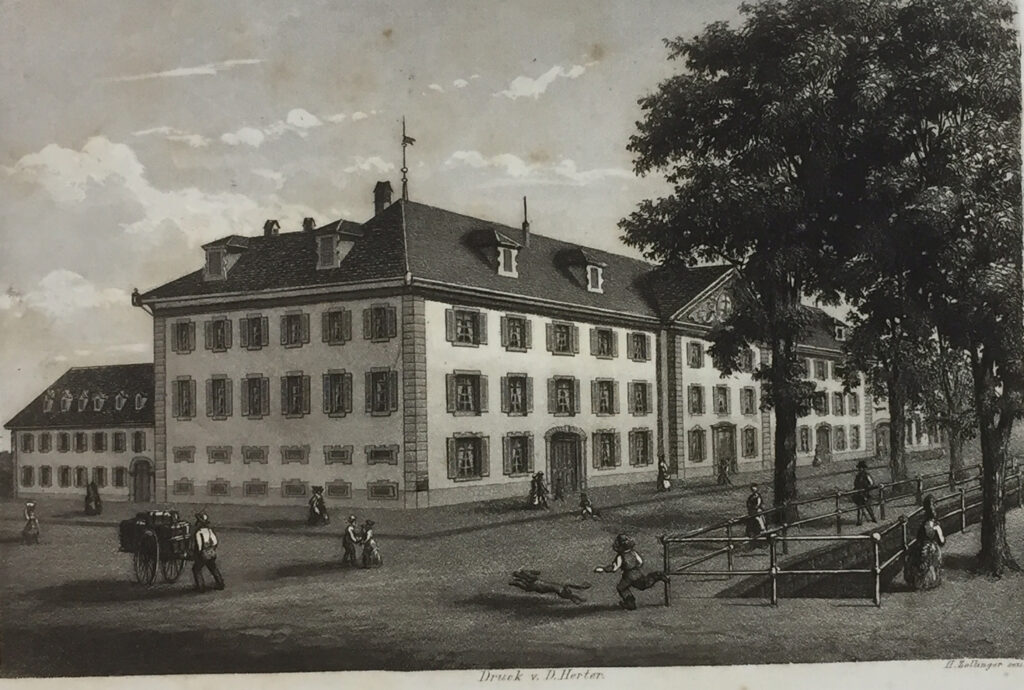
Source: ZHB Luzern Sondersammlung
From the perspective of non-motorised traffic, the historical depiction of the Bürgerspital almost makes me wistful. Instead of an avalanche of cars, the Krienbach stream flowed through this part of town until the 1890s and children could apparently still chase after dogs without being harmed by traffic. Under the impression of particularly devastating smallpox epidemics and the increasingly precarious situation in the Bürgerspital, the city planned an isolated building for patients with infectious diseases in the second half of the 19th century. Various options were examined but always rejected, not least because of the opposition of residents and owners of the neighbouring properties.3Meyer, Renward 1871. Memorial betreffend das projektirte Absonderungshaus des Bürgerspitals. Meyer’sche Buchdruckerei: Luzern It was not until thirty years later, and in the meantime under pressure from the new federal epidemic law, that the city authorities succeeded in putting a new isolation house into operation on what was then the outskirts of the city. Since this house is still there, I decide to conclude my tour with a visit to this building. The way to the isolation house turns out to be a time travel through Lucerne’s medical history.
The Great Pox House and Other Hospitals
With the former Bürgerspital behind me, I turn into the “lesser town” and drive past the west wing of the cantonal government building. The city of Lucerne’s Holy Spirit Hospital stood on this site from the 13th to the 17th century. At that time it was located in the part of the city through which pilgrims passed who travelled from the north over the St. Gotthard Pass to Rome.4Hermann, Claudia 2004. Das Luzerner Armenspital. Eine Architekturgeschichte mittelalterlicher und frühneuzeitlicher Spitalbauten im eidgenössischen und europäischen Vergleich. Schwabe: Basel, S. 53–55.

The location was probably deliberately chosen, because hospitals at that time were not so much places of healing practice, but in particular inns for pilgrims and hostels for poor people. During the plague waves, this exposed situation became a problem, as the travellers also brought the plague with them into the city. Because of this, the first known plague ordinance of the Swiss Confederation was issued in Lucerne in 1580, and traffic was reduced to a minimum by closing the borders. Unlike the countryside or other Swiss cities, the city of Lucerne was therefore spared greater hardship in the plague waves of the 17th century. On my way to the isolation house, a few metres further on I pass the oldest pharmacy still in existence in the city.

After the pharmacy, I come to the Reuss and pass the site of the former “Blatternhaus”, the isolation place for syphilis patients. Today however, nothing can be seen of it. Nowadays, the Geissmatt Bridge crosses the Reuss in its place. Until the 18th century, various asylums were grouped here to care for the sick, the insane, the dissolute or otherwise conspicuous. At the time, this was outside the city walls. 5Horat, Heinz 2008. Architektur und Städtebau im Untergrund. Die Geschichte vom Leben im Quartier in: Alex Willener et. al. Projekt BaBeL: Quartierentwicklung im Luzerner Untergund. Interact: Luzern, S. 12–15 In a south-westerly direction, just over a hundred metres away, was the Sentispital with its infirmary for lepers. Today, the Sentikirche with its neo-classical façade added in 1819 is all that remains of it. Diagonally opposite was the St. Jacob’s Hospital, a hostel for pilgrims to Santiago. But women suspected of witchcraft and, a bit later, beggars and vagrants were also kept there. From 1739 it was an orphanage.6Göttler, Werner 2001. Jakobus und die Stadt. Luzern am Weg nach Santiago de Compostela. Schwabe: Basel, S. 139–187 In the meantime, a prison and the municipal barracks were also located in this area. Since the opening of the motorway in the 1970s, however, this area has been entirely dominated by the automobile and is mainly characterised by traffic, a motorway feeder road and a bulky multi-storey car park with a pedestrian overpass.
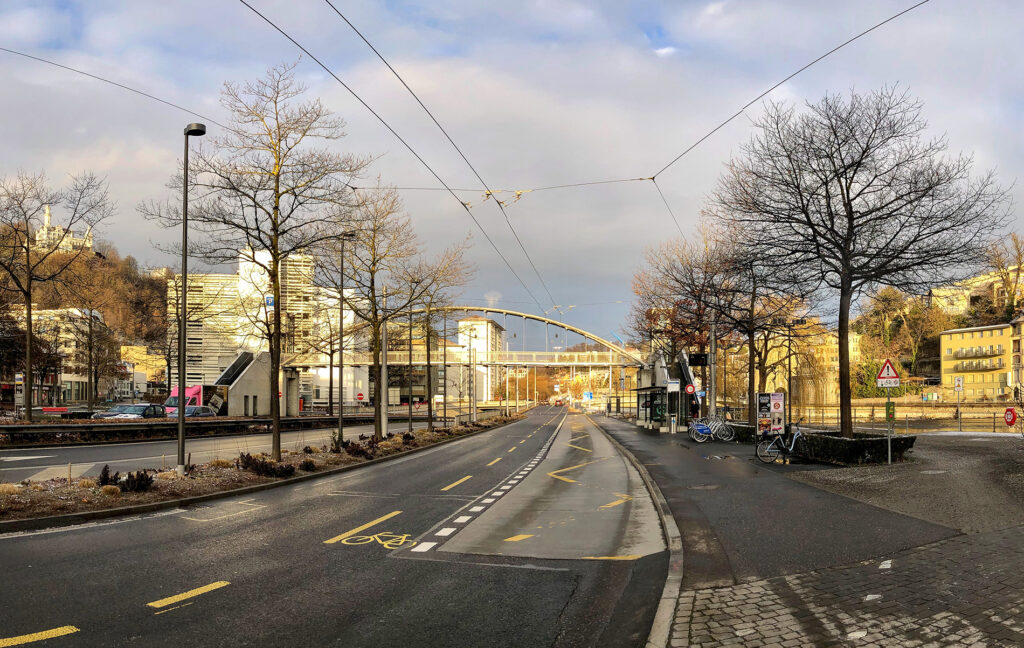
One constant of this district – aptly named “Untergrund” [underground in English] – is its comparatively underprivileged status. The city council writes about this neighbourhood in 1886:
“Only the area of the Untergrund, where sewers are almost completely lacking, has remained unchanged in its underground installations, although the need for an orderly sewage system is no less noticeable there than in other parts of the city. In particular, the dry summer of 1885 cast a harsh light on the existing evils, as the open sewers, filled with dirty water due to a lack of intermittent rinsing, polluted the surrounding area.”7quoted from Horat, Heinz 2008. Architektur und Städtebau im Untergrund. Die Geschichte vom Leben im Quartier in: Alex Willener et. al. (eds.) Projekt BaBeL: Quartierentwicklung im Luzerner Untergund. Interact: Luzern, S. 19.
The Untergrund was one of the last districts to benefit from the establishment of a sewerage system. The underground sewage systems are – at least to the unknowing eye – one of the most invisible effects of the pandemics and the new medical knowledge of the 19th century. At the same time, however, they are arguably one of the most sustainable public measures to control contagions, in both urban planning and hygienic terms.

Source: Staatsarchiv Luzern, PL5258
The Cantonal Health Institution
On my bike tour I leave the Untergrund and cross the Reuss on the Geissmatt bridge. Shortly afterwards I pass the cantonal hospital. Founded in 1902 as the “Cantonal Health Institution”, the clinic became the modern successor to the Bürgerspital. In order to distinguish the new institution from the former hostel for the poor in the Obergrund, the name “hospital” was deliberately omitted at first. It was not until 1938 that it was included again when the name was changed to what is now the “Cantonal Hospital”. The new hospital was built on the periphery of the city, on the still undeveloped St. Karli Heights.8Hermann, Claudia 2002. Gesundheit ist Lebensqualität: 100 Jahre Kantonsspital Luzern. Eine Ausstellung des Historischen Museums Luzern. Historisches Museum Luzern: Luzern.

Source: Kantonale Denkmalpflege Luzern (photograph by Emil Goetz)
Since then, it has become a modern centre hospital, in line with the current state of medical research. The residential buildings now extend right up to the hospital and it is well integrated into urban life by access roads and several bus routes.
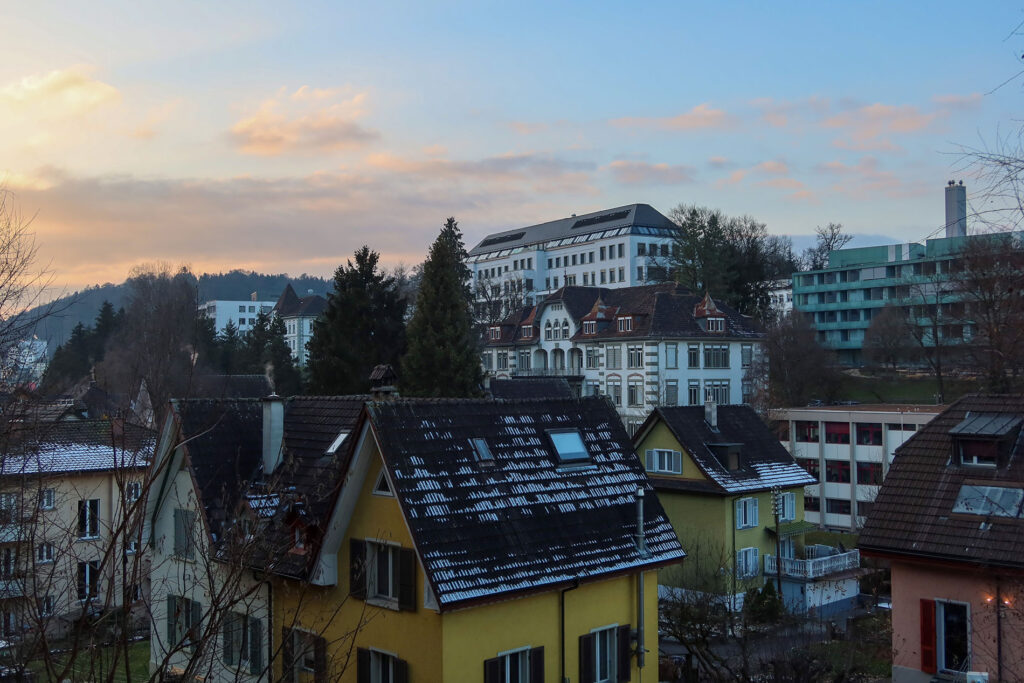
Through additions and renovations, the hospital has continued to develop and today consists of a collection of buildings and special clinics with the hospital centre, inaugurated in 1982, as the prominent eye-catcher. In the current expansion phase, a new women’s clinic and a children’s hospital are being built and are scheduled to open in 2025.

The Isolation House in Hintergopplismoos
Repeated outbreaks of smallpox, Lucerne’s importance as a tourist destination and political pressure from the then new federal epidemic law for “protection against epidemics dangerous to the public” in 1886 gave great urgency to the construction of a specific building for the isolation of infectious patients. The spatial isolation of the sick was the only effective method of preventing epidemics. Today, at least in the case of bacterial infections, antibiotics and infection rooms with negative pressure systems also help.9Lang, Beatrix 1995. Das Absonderungshaus im Hintergopplismoos. Luzerner Hauskalender (Meyer-Brattig). Jg. 194, S. 60–62
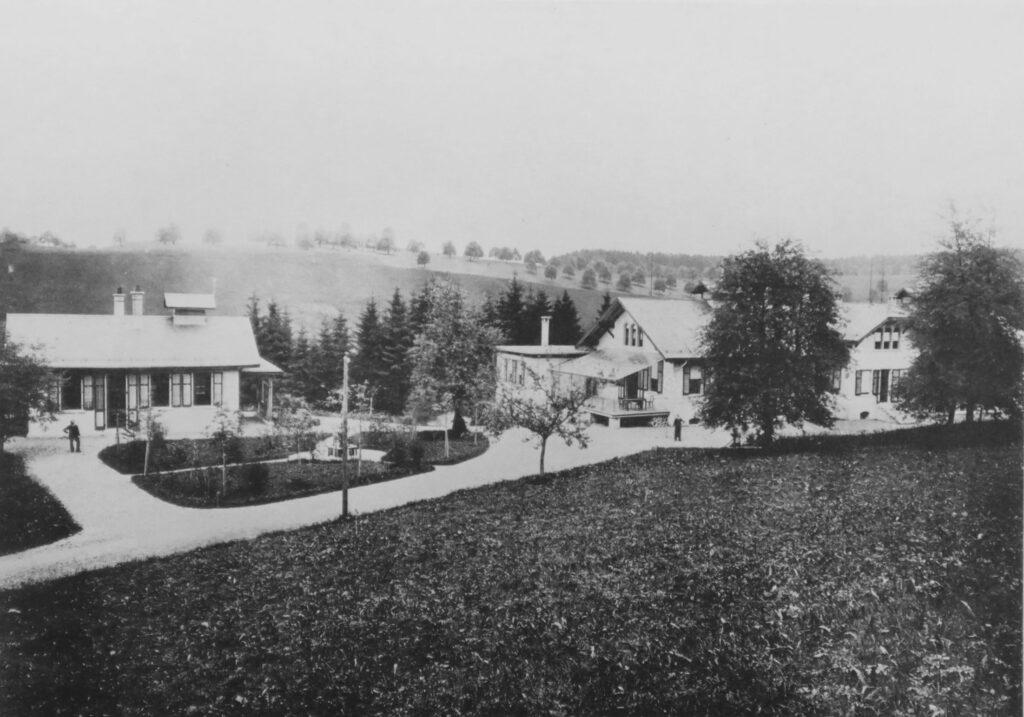
Source: Luzern Absonderungshaus und Desinfektionsanstalt Luzern, ZHB Luzern
After a number of provisional arrangements and protracted quarrels about the location, the city of Lucerne was able to put the new isolation house into operation in 1896 on Gopplismoos, which was still vacant and far from the city at the time. It consisted of the actual hospital with symmetrically arranged and gender-separated dormitories and the disinfection facility with a disinfection apparatus. In the event of an epidemic, the house was maintained by a pair of caretakers who took care of disinfection, heating and the kitchen. The nursing staff and a doctor in charge cared for the sick.

Source: Absonderungshaus und Desinfektionsanstalt Luzern, ZHB Luzern
Until the beginning of the 1950s, the houses were still used to isolate patients with infectious diseases or suspected cases. After that, the hygienic and technical facilities had become obsolete, and so had the buildings. After a renovation, the municipal youth hostel moved into the facility in 1953. In its first year at the new location, the hostel was already visited by 15,000 guests, about 80 per cent of whom came from abroad. With the exception of members of the former Eastern Bloc, all European nations were represented among the guests. In addition, there were travellers from the USA, Canada, New Zealand and Australia, South Africa, India and other Asian countries.10Luzerner Tagblatt, 13. April 1954; Luzerner Neueste Nachrichten, 21. August 1954
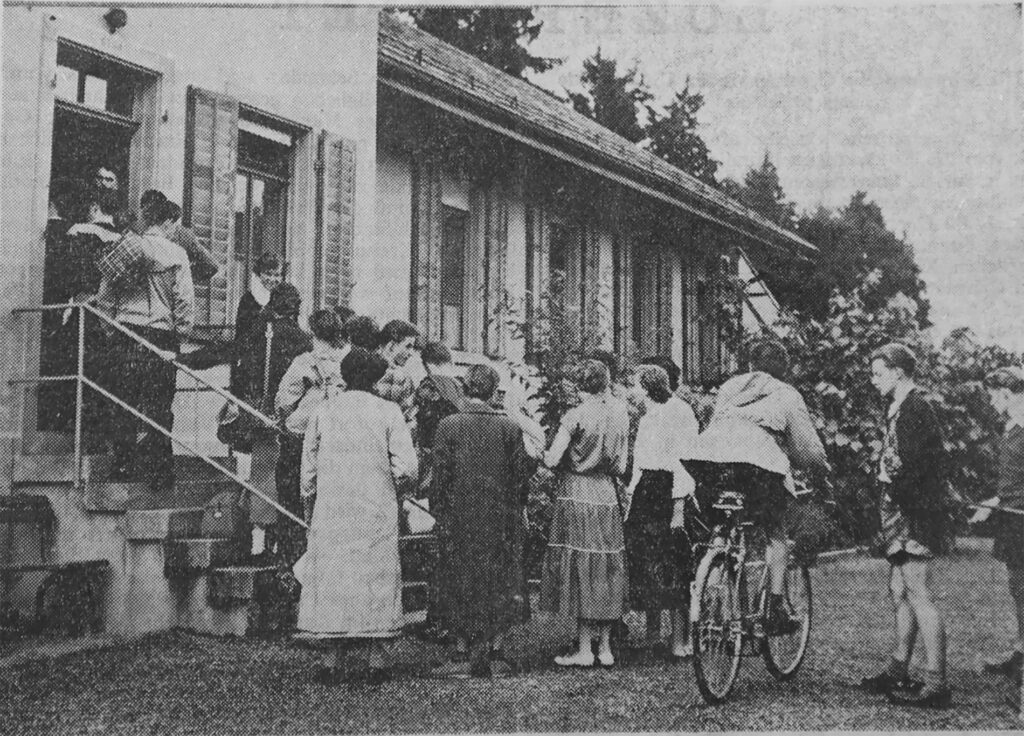
Source: Stadtarchiv Luzern, B3.29/A448
In the late 1970s, the youth hostel moved a few houses to a new building and the isolation house has since been used as an artist’s studio. Externally, the isolation house has hardly changed in the last 120 years, but the surroundings have changed. While the isolation house was still secluded on the outskirts of the city when it first opened, it is now surrounded by residential buildings.

Devastating and Inconspicuous
On the way home, I cycle past the new youth hostel. During the first wave of the Corona pandemic in spring 2020, mobilised hospital soldiers were accommodated there. They were on duty in the cantonal hospital nearby. Pedalling and looking for the historic sites bound my attention along the way. For a moment, I forgot about the pandemic and a light-heartedness set in. In the end, I was surprised at how many places with a medical-historical connection I came across. Unlike many political places of remembrance, which usually communicate their purpose very clearly as monuments or representative buildings, you have to rely on prior knowledge, experts or friendly passers-by to discover the traces of epidemics. It seems that past diseases – although devastating at the time – have only inscribed themselves inconspicuously in our environment. Conversely, social use of the environment and the social-geographical situation shape the spread of diseases. Lucerne, as a place of transit for traders and pilgrims, and later as a tourist destination, was always exposed to pandemics. In times of plague, border closures were imposed which was certainly useful. In the current pandemic, too, national borders have special significance and entry and exit have become more difficult. Borders (again) become obstacles that cannot be overcome so easily – although in the present, paradoxically, the pathogens are just everywhere.

Since borders are usually at the maximum distance from the centre, they were historically the preferred place for segregating the sick. In the respective period, the isolation houses were always located in the periphery and were then caught up again by the growing city. In the Covid-19 pandemic, however, isolation seems to have shifted to the centre of society. Sick people are no longer geographically segregated, but are expected to take responsibility for their own inner-worldly isolation. And even when hospitalisation is medically necessary, patients are no longer spatially removed, but functionally isolated so that a highly specialised care is possible. Nevertheless, the temporary isolation and the accompanying reduction in contact is now, as it was then, a burden for the individual person. Nevertheless, isolation is still an effective means of reducing infection rates and protecting the population from the rampant diseases. At the present we can only hope that the vaccination campaigns will soon fulfill their purpose and the current measures to combat the pandemic will become a thing of the past. It remains to be seen what visible signs will remain from this pandemic, especially – and hopefully – in the area of cycling infrastructure.

Map
Footnotes

